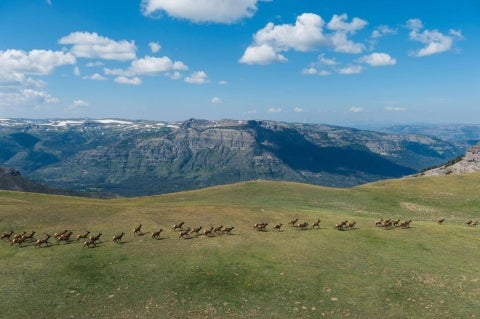Note: Yale School of the Environment (YSE) was formerly known as the Yale School of Forestry & Environmental Studies (F&ES). News articles and events posted prior to July 1, 2020 refer to the School's name at that time.
The May issue of National Geographic magazine, which appeared on newsstands this week, features research, including a special map supplement, by Arthur Middleton ’07 M.E.M., associate research scientist at the Yale School of Forestry & Environmental Studies (F&ES). The issue, written entirely by David Quammen, explores the social, ecological, and political complexities of the Greater Yellowstone Ecosystem (GYE).
 Arthur Middleton’s research focuses on elk migrations in the Greater Yellowstone Ecosystem.
Arthur Middleton’s research focuses on elk migrations in the Greater Yellowstone Ecosystem.
Middleton’s research focuses on elk migrations in the GYE. Along with wildlife photojournalist Joe Riis, he spent the past two years following elk from their winter range to their summer range high in Wyoming’s Absaroka Range. Last fall, Middleton and Riis were named Adventurers of the Year by National Geographic.
“Arthur’s really opened up a lot of doors for me,” Riis said. “I’ve worked with scientists on a continual basis since I started photographing full time, but I’ve never partnered on a long-term project where I spent a lot of time with one researcher documenting their work for, say, two years.”
The team won the inaugural Camp Monaco Prize, which recognized their efforts to link scientific exploration and public outreach on the subject of trans-boundary wildlife migrations in the GYE. Their project, the Greater Yellowstone Migrations, which also includes artist James Prosek and is featured in a new documentary film by Jenny Nichols, will be highlighted at this weekend’s Science & Storytelling Symposium hosted by F&ES.
“Science can help restore our sense of wonder at nature,” Middleton says, “but to do that it has to be more than words on a page.”
“Arthur’s really opened up a lot of doors for me,” Riis said. “I’ve worked with scientists on a continual basis since I started photographing full time, but I’ve never partnered on a long-term project where I spent a lot of time with one researcher documenting their work for, say, two years.”
The team won the inaugural Camp Monaco Prize, which recognized their efforts to link scientific exploration and public outreach on the subject of trans-boundary wildlife migrations in the GYE. Their project, the Greater Yellowstone Migrations, which also includes artist James Prosek and is featured in a new documentary film by Jenny Nichols, will be highlighted at this weekend’s Science & Storytelling Symposium hosted by F&ES.
“Science can help restore our sense of wonder at nature,” Middleton says, “but to do that it has to be more than words on a page.”
– Timothy Brown timothy.brown@yale.edu
Published
April 21, 2016